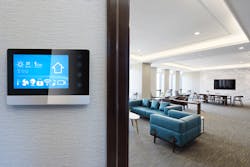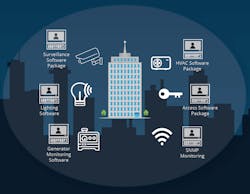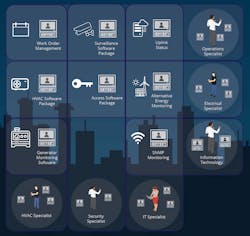Reap Actionable Data Analytics from Building Systems with IoT Platforms
By MICHAEL C. SKURLA, BitBox USA, Nashville TN
There’s been an upheaval in the commercial building space over the last several years. Holistically all trades have chased efficiency within their respective silos for decades. From HVAC tied to BMS solutions, to lighting and water, manufacturers have focused on the core tenet that product improvements are directly related to energy savings.
This has overall been an exceptional tactic since meeting the new energy codes and the “Green” sentiment both have a positive impact on OpEx. Starting in 2010, however, the residential market shifted with the entry of IoT devices initially reserved for more technologically advanced users. Smart home tech such as the NEST thermostat (and EcoBee alike) and the growth of intelligent appliances and home automation trickled out of the high-end market and into mainstream homes worldwide.
This drive, due for the most part to the proliferation of smartphones and Wi-fi, and the “always-on” necessity, fundamentally changed user connectivity levels and the built world (in this case the home). The once siloed technology, the purview of ‘specialists’ became available to the consumer sector and revolutionized engagement with building technology.
The IoT Myth
Soon after these technologies were introduced to the consumer sector, Internet of Things (IoT) marketing hit the press with a rabid force. For decades, the building trades had manufactured devices that communicated: from thermostats, RTUs, to VAV controllers, to lighting systems. While all of these ‘talked’ and integrated into other devices, they only communicated their intended function. A thermostat could ‘talk’ to an RTU to turn on air conditioning, and to a BMS controller for facility monitoring. The limited extent of this communication offered only restricted possibilities for data mining from these devices and often lacked access to the full breadth of available data.
IoT was marketed as a be-all, end-all solution to just about everything. The phrase was liberally peppered in marketing material from PTACs to powder-coated paints. The fact that devices had been communicating for quite some time, made this liberal usage of this acronym rightfully confusing.
So, what is IoT? What are its practical potentials within the commercial facilities space?
Redefined by Analytics
Google the acronym “IoT” and you will find many definitions.
One thing is clear: IoT is not a product, nor a standardized means to communicate. It is simply a contract to communicate data. The IoT value is not in its device hardware, but the ability to communicate beyond a specific trade.
For instance, a thermostat is not an IoT device. In fact, it may communicate in a completely proprietary way. However, the upstream controller dealing with this thermostat should be able to communicate the temperature, set-point, humidity, and metrics with ease, and to a defined IT standard. This simply means something beyond the BMS, or HVAC can access that data and utilize it for other purposes within other trades, or analytics.
Compared to traditional siloed building technology at the heart of the industry adoption premise, the IoT contract enables two major driving factors:
• Business Intelligence through personalization, and
• Increased OpEx performance through synergies — in addition to the OpEx savings already established through modern data equipment and controls utilization.
Business Intelligence Through Personalization
Data analytics is a growing science in the commercial building space driven by the IoT contract. Micro-service analytics is focused on the ability to collect data from traditionally disjointed sources, most notably building technologies, and convert them into actionable Business Intelligence (BI) far beyond mere facility management.
The technology placed in facilities for specific purposes — thermostats, air quality sensors, lighting motion sensors, even elevator activity logs — has far greater potential outside of the specific functions for which it is installed. That potential can only be reaped if these devices can ‘talk’ to a larger audience and be analyzed from the perspective of various stakeholders.
This rapidly growing micro-service analytics marketplace uses organized data-lakes of IoT and facility data in different perspectives for various stakeholders. For instance, data from motion sensors attached to HVAC and lighting equipment is used for marketing insights in retail settings. Portfolio leasing can be analyzed via IWMS software solutions on that same data, and the list goes on and on.
While every facility can aggregate data, the challenge is to utilize the data for far greater impacts than merely preventative maintenance and facility efficiency.
Increased OpEx Performance Through Synergies
No doubt operational efficiency cannot be overlooked. A typical commercial building has no less than seven communicating subsystems (often many more). Generally, each of these sub-systems has its software and analytics platforms for monitoring and management, as well as for managing its network of devices.
This traditional setup not only results in a significant amount of duplication of effort (wiring, configuration, and commissioning), but it also requires staff to be versed in various systems and software to ascertain and comprehend the actionable data. This hinders the ability to leverage data between various existing systems throughout the facility.
Take for example that aforementioned thermostat providing information on consistent operations of a Roof Top Unit (RTU). Set to operate at 74F, it would strive to maintain this temperature at all cost. A BMS system could easily determine that the RTU was running constantly and generate a truck roll to address the issue. However, if it was also connected to the security system, a truly synergistic solution would understand that the backdoor was open, and wouldn’t warrant a truck roll, but a phone call to ask staff to close the door. This saves both a truck roll expense, as well as energy, offering an expedited resolution.
Data Collection and Organization is the Key
The IoT ecosystem available in the market today solves this age-old dilemma of collective monitoring without disrupting the efficiency of individual subsystems, and the BMS solutions currently integrated into the individual building space. IoT Ecosystems are not BMS frameworks. They are data collaboration technologies, born out of IT philosophies and processes laid on top of existing and emerging building technology, allowing the massive collection of building data to be organized and delivered to AI services for actionable analytics.
They don’t solely focus on building technology, but on all the data within a building that is ascertainable from a different approach:
- Collecting — A single appliance is wired into each facility in a portfolio to collect everything it can find in building and IoT technologies, and funnel it, securely, to a cloud application engine;
- Organizing — Within the cloud the data is organized and rationalized into concise datasets, eliminating the disjointed and often confusing mix of data between brands of equipment, and facility locations globally;
- Delivering — Offers a standard consolidated Application Programming Interface (API) to allow easy third-party data mining from micro-service analytics providers to meet the needs of varying stakeholders.
Given their IT-centric approach, the current IoT ecosystems designed for commercial buildings offer massive scale and possibilities for data mining and actionable analytics. This scale allows for easy distribution and management across hundreds and thousands of portfolio locations on what was traditionally a costly task within legacy BMS frameworks.
By integrating IoT platforms, commercial building operators are poised to take full advantage of the installed systems in a vastly distinctive, and more affordable methodology than the legacy technologies. More importantly, IoT platforms eliminate the complexity of data aggregation and open data-driven decision-making opportunities, crucial for any enterprise and its stakeholders.
This wealth of possibilities, new services, and options for commercial buildings is as, if not more valuable than how consumers have leveraged connectivity intelligence from their home technologies.
It’s time for next-gen smart decision-making for facilities’ operators — with readily available and easily interoperable IoT tools that can empower existing systems.













